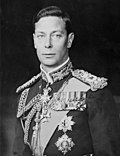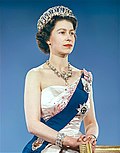Dominion of Pakistan
This article needs additional citations for verification. (February 2014) |
Federation of Pakistan[1] | |||||||||
|---|---|---|---|---|---|---|---|---|---|
| 1947–1956[2] | |||||||||
| Anthem: Qaumi Taranah (1954–56) | |||||||||
 Land controlled by the Dominion of Pakistan shown in dark green; land claimed but not controlled shown in light green | |||||||||
| Capital | Karachi | ||||||||
| Official languages | Englisha | ||||||||
| Recognised national languages | Urdub, Bengalic | ||||||||
| Religion | Islam (majority) Hinduism Sikhism Christianity | ||||||||
| Demonym(s) | Pakistani | ||||||||
| Government | Federal parliamentary constitutional monarchy | ||||||||
| Monarch | |||||||||
• 1947–1952 | George VI | ||||||||
• 1952–1956 | Elizabeth II | ||||||||
| Governor-General | |||||||||
• 1947–1948 | Muhammad Ali Jinnah | ||||||||
• 1948–1951 | Khawaja Nazimuddin | ||||||||
• 1951–1955 | Malik Ghulam | ||||||||
• 1955–1956 | Iskander Mirza | ||||||||
| Prime Minister | |||||||||
• 1947–1951 | Liaquat Ali Khan | ||||||||
• 1951–1953 | Khawaja Nazimuddin | ||||||||
• 1953–1955 | Mohammad Ali Bogra | ||||||||
• 1955–1956 | Chaudhry Mohammad Ali | ||||||||
| Legislature | Constituent Assembly | ||||||||
| History | |||||||||
| 14 August 1947[3] | |||||||||
• Republican constitution adopted | 23 March 1956 | ||||||||
| Area | |||||||||
| 1956 | 943,665 km2 (364,351 sq mi) | ||||||||
| Currency | Pakistani rupee | ||||||||
| |||||||||
| Today part of |
| ||||||||
a. Official Language: 14 August 1947 b. First National Language: 23 February 1948 c. Second National Language: 29 February 1956 | |||||||||
The Federation of Pakistan,[1] also called the Dominion of Pakistan,[4] was an independent federal dominion in South Asia that was established in August 1947.
At its inception on 14 August 1947, the Dominion of Pakistan, similarly to the neighbouring Dominion of India, did not include its princely states, which gradually acceded over the next year. The nation's status as a federal dominion within the British Empire ended in 1956 with the formal drafting of the Constitution of Pakistan, which officially established the country as the Islamic Republic of Pakistan. The constitution also administratively split the nation into West Pakistan and East Pakistan, which were until this point governed as a singular entity despite being completely separate geographic exclaves. In 1971, following a liberation war between Pakistan Armed Forces (aided by East Pakistani loyalists) and ethnic Bengali rebels known as the Mukti Bahini, the territory of East Pakistan seceded from the union with Indian military support to form the independent People's Republic of Bangladesh.
Partition of British India[]
Section 1 of the Indian Independence Act 1947 provided that from "the fifteenth day of August, nineteen hundred and forty-seven, two independent dominions shall be set up in India, to be known respectively as India and Pakistan." The Dominion of India held seventy-five percent of the territory and eighty percent of the population of the former British India. As it was already a member of the United Nations, India continued to hold its seat there and did not apply for a new membership. The British monarch became head of state of the new dominion, with Pakistan sharing a king with the United Kingdom and the other Dominions of the British Commonwealth, and the monarch's constitutional roles in Pakistan were delegated to the Governor-General of Pakistan.
Before August 1947, about half of the area of present-day Pakistan was part of the Presidencies and provinces of British India, in which the agents of the sovereign as Emperor of India had full authority, while the remainder were princely states in subsidiary alliances with the British, enjoying internal self-government. The British abandoned these alliances in August 1947, leaving the states entirely independent, and between 1947 and 1948 the states all acceded to Pakistan, while retaining internal self-government for several years.
Territory[]
The dominion began as a federation of five provinces: East Bengal (later to become Bangladesh), West Punjab, Balochistan, Sindh, and the North-West Frontier Province (NWFP). Each province had its own governor, who was appointed by the Governor-General of Pakistan. In addition, over the following year the princely states of Pakistan, which covered a significant area of West Pakistan, acceded to Pakistan. They included Bahawalpur, Khairpur, Swat, Dir, Hunza, Chitral, Makran, and the Khanate of Kalat.
Radcliffe Line[]
The controversial Radcliffe Award, not published until 17 August 1947 specified the Radcliffe Line which demarcated the border between the parts of British India allocated to the two new independent dominions of India and Pakistan. The Radcliffe Boundary Commission sought to separate the Muslim-majority regions in the east and northwest from the areas with a Hindu majority. This entailed the partition of two British provinces which did not have a uniform majority — Bengal and Punjab. The western part of Punjab became the Pakistani province of Punjab and the eastern part became the Indian state of Punjab. Bengal was similarly divided into East Bengal (in Pakistan) and West Bengal (in India).
Monarchy in the Dominion[]
Under the Indian Independence Act 1947, British India was to be divided into the independent sovereign states of India and Pakistan. From 1947 to 1952, George VI was the sovereign of Pakistan, which shared the same person as its sovereign with the United Kingdom and the other Dominions in the British Commonwealth of Nations.[5][6]
Following George VI's death on 6 February 1952, his daughter Princess Elizabeth, who was in Kenya at that time, became the new monarch of Pakistan. During the Queen's coronation in 1953, Elizabeth II was crowned as Queen of seven independent Commonwealth countries, including Pakistan.[7] In her Coronation Oath, the new Queen promised "to govern the Peoples of ... Pakistan ... according to their respective laws and customs".[8] The Standard of Pakistan at the Coronation was borne by Mirza Abol Hassan Ispahani.[9]
Pakistan abolished the monarchy on the adoption of a republican constitution on 23 March 1956.[10] However, Pakistan became a republic within the Commonwealth of Nations. The Queen sent a message to Pakistanis which said, "I have followed with close interest the progress of your country since its establishment ... It is a source of great satisfaction to me to know that your country intends to remain the Commonwealth. I am confident that Pakistan and other countries of the Commonwealth will continue to thrive and to benefit from their mutual association".[11]
The Queen visited Pakistan as Head of the Commonwealth in 1961 and 1997, accompanied by Prince Philip, Duke of Edinburgh.[12]
Pakistan left the Commonwealth in 1972 over the issue of the former East Pakistan province becoming independent as Bangladesh. It rejoined in 1989, then was suspended from the Commonwealth twice: firstly from 18 October 1999 to 22 May 2004 and secondly from 22 November 2007 to 22 May 2008.
List of heads of state[]
Monarchs[]
From 1947 to 1956, Pakistan was a constitutional monarchy. The Pakistani monarch was the same person as the sovereign of the nations in the British Commonwealth of Nations.[13][6]
| Portrait | Name | Birth | Reign | Death | Consort | Relationship with Predecessor(s) | Royal House |
|---|---|---|---|---|---|---|---|

|
George VI | 14 December 1895 | 14 August 1947 – 6 February 1952 |
6 February 1952 | 
Queen Elizabeth |
None (position created). Emperor of India before partition. | Windsor |

|
Elizabeth II | 21 April 1926 | 6 February 1952 – 23 March 1956 |
Living | 
Prince Philip, Duke of Edinburgh |
Daughter of George VI |
Governors-General[]
The Governor-General was the representative of the monarch in the Dominion of Pakistan.[14]
| Picture | Name
(birth–death) |
Took office | Left office | Appointer |
|---|---|---|---|---|

|
Muhammad Ali Jinnah
(1876–1948) |
15 August 1947 | 11 September 1948 | 
George VI |

|
Sir Khawaja Nazimuddin
(1894–1964) |
14 September 1948 | 17 October 1951 | |

|
Sir Ghulam Muhammad
(1895–1956) |
17 October 1951 | 7 August 1955 | |

Elizabeth II | ||||

|
Iskander Mirza
(1899–1969) |
7 August 1955 | 23 March 1956 |
Notes[]
References[]
- ^ Jump up to: a b Nalanda Year-book & Who's who in India, University of California, 1949,
The main difference between the Pakistan Order and the India Order is that the Act as adapted for Pakistan refers to the Federation of Pakistan instead of the Dominion of Pakistan and the terminology of the existing Act is preserved
- ^ Timothy C. Winegard (29 December 2011). Indigenous Peoples of the British Dominions and the First World War (1st ed.). Cambridge University Press. p. 2. ISBN 978-1107014930. Retrieved 11 August 2013.
- ^ Singh Vipul (1 September 2009). Longman History & Civics Icse 10. Pearson Education India. pp. 132–. ISBN 978-81-317-2042-4.
- ^ As to official name being just "Pakistan" and not "Dominion of Pakistan": Indian Independence Act 1947, Section1.-(i) As from the fifteenth day of August, nineteen hundred and forty-seven, two independent Dominions shall be set up in India, to be known respectively as India and Pakistan."
- ^ Matthew, H. C. G. (September 2004). "George VI". Oxford Dictionary of National Biography (online ed.). Oxford University Press. doi:10.1093/ref:odnb/33370. Retrieved 20 April 2008.
India and Pakistan remained among the king's dominions but both were set on republican courses, becoming republics within the Commonwealth in 1950 and 1956 respectively.
(Subscription or UK public library membership required.) - ^ Jump up to: a b Kumarasingham, Harshan (2013), THE 'TROPICAL DOMINIONS': THE APPEAL OF DOMINION STATUS IN THE DECOLONISATION OF INDIA, PAKISTAN AND CEYLON, vol. 23, Transactions of the Royal Historical Society, p. 223
- ^ "The Coronation of Queen Elizabeth II". Retrieved 16 May 2014.
- ^ "The Form and Order of Service that is to be performed and the Ceremonies that are to be observed in the Coronation of Her Majesty Queen Elizabeth II in the Abbey Church of St. Peter, Westminster, on Tuesday, the second day of June, 1953". Oremus.org. Retrieved 3 February 2013.
- ^ https://www.thegazette.co.uk/London/issue/40020/supplement/6240 The London Gazette, no. 40020 of 20 November 1953, pp. 6240 ff.
- ^ John Stewart Bowman (2000). Columbia chronologies of Asian history and culture. Columbia University Press. p. 372. ISBN 978-0-231-11004-4. Retrieved 22 March 2011.
- ^ Page 7
- ^ "Commonwealth visits since 1952". Official website of the British monarchy. Archived from the original on 12 April 2015. Retrieved 4 September 2012.
- ^ Winegard, Timothy C. (2011), Indigenous Peoples of the British Dominions and the First World War, Cambridge University Press, p. 2, ISBN 978-1-107-01493-0
- ^ Chief Justice Muhammad Munir: His Life, Writings, and Judgements, Research Society of Pakistan, 1973, p. 341
Further reading[]
- Chester, Lucy P. (2009) Borders and Conflict in South Asia: The Radcliffe Boundary Commission and the Partition of Punjab. Manchester: Manchester University Press.
- Read, A. and Fisher, D. (1997). The Proudest Day: India's Long Road to Independence. New York: Norton.
- Former Commonwealth realms
- Former polities of the Cold War
- Former countries in South Asia
- Muhammad Ali Jinnah
- Pakistan and the Commonwealth of Nations
- Pakistan–United Kingdom relations
- Partition of India
- Politics of Pakistan
- States and territories established in 1947
- 1947 establishments in Pakistan
- 1956 disestablishments in Pakistan

